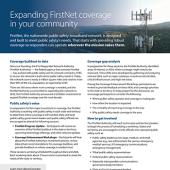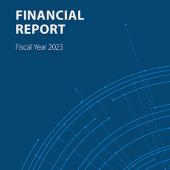Emergency management thrives on good communications. One FirstNet tool that aids communications is push-to-talk on hand-held mobile devices. Push-to-talk capabilities over FirstNet deliver better situational awareness for responders in the field and in the emergency operations center (EOC).
Creating a common operating picture
Inside the EOC, the most pressing questions for emergency managers often are “where is my stuff?” and “where are my people?”
Emergency managers rely on responders in the field to answer these questions. Push-to-talk capabilities over LTE can allow you to receive robust information and help create a common operating picture for everyone. Many push-to-talk apps can allow you to share data, including photos, videos, GPS locations, links to online resources, and more.
Photos and videos can tell a better story of what’s happening than voice communications alone. When a child is lost in the commotion of a local county fair, responders throughout the fairgrounds help with the search. Instead of relaying a verbal description alone, push-to-talk apps can have the capability to let you share a picture of the missing child with all responders simultaneously.
Supplementing LMR
For responders in the field, push-to-talk over FirstNet offers a way to extend and expand your communications. FirstNet Push-to-Talk can integrate with land mobile radios to extend communication capabilities without additional expensive LMR devices.
Push-to-talk apps can extend the range of a land mobile radio system, as the system can be used from anywhere in the country while still communicating with your radio network back home. Push-to-talk over broadband can also be useful inside buildings where radio signals may not get through, but broadband works.
When push-to-talk over FirstNet is used in a disaster, it can reduce traffic on area radio systems. Instead of using radios for every communication—often resulting in congested networks and busy signals—non-emergency traffic can be handled via push-to-talk.
Push-to-talk can also handle emergency communications. A rare tornado hit northern Michigan, wiping out homes and businesses and injuring residents of Otsego County. Incident commander Gavin Babieracki said, “When I was initially getting the EOC established, I was carrying seven different 800-megahertz radios. Then we discovered that our 800-megahertz system became overwhelmed.” They turned to FirstNet, setting up talk groups using FirstNet push-to-talk so responders could easily connect with each other.
By pairing push-to-talk with land mobile radios you create two communications systems, which creates redundancy. Push-to-talk is another tool in your communications toolbox to fall back on.
Reaching all responders
No matter who you need to communicate with from the EOC, push-to-talk can help connect you.
Emergency managers coordinate a lot of volunteers, whether from the Red Cross or for search and rescue missions. With some pre-planning to use or distribute matching products, FirstNet’s push-to-talk capabilities can allow you to quickly scale and deploy your communications to people who don't typically work with you—such as volunteers, agencies involved in mutual aid, or others who are essential to response coordination.
Rather than handing out expensive radios and trying to teach someone on the fly how to use one, you can get the same communications capability by licensing a push-to-talk product on a consumer device, something that most people already have in their pocket. Or you can keep a cache of FirstNet devices on hand to distribute in an emergency because the average person will already know how to operate one.
Cost considerations
Push-to-talk over FirstNet can provide opportunities for cost savings. When the Dallas Police Department in Georgia switched to FirstNet from land mobile radios as their primary communications platform, cost was a major factor in the decision. Implementing FirstNet was a fraction of the cost of a new 800-megahertz radio system, even with FirstNet’s monthly subscription cost.
The benefits extend to device costs. “The cost of the [FirstNet] devices our officers are using is $1 compared to the cost of an actual LMR, which is close to $1,000,” said Dallas Police Chief Joe Duvall. This low cost allows the department to always have plenty of backup devices ready to go.
Push-to-talk can be a more cost-efficient way for first responders to communicate with community partners during an emergency. Public safety needs a direct communication line with utility workers when a disaster causes an outage or with school staff when an incident occurs at school. Push-to-talk apps can give these users the ability to stay connected, especially in an emergency, without needing their own expensive radios.
Benefits of push-to-talk on FirstNet
FirstNet provides features not found on other carriers. Certain push-to-talk options are built into the network core, so there's less latency and the service has all the public safety features unique to FirstNet, including:
- Control of network resources. Using FirstNet Central and the FirstNet Push-to-Talk product, administrators can manage push-to-talk for their agencies. They can create talk groups and contacts and push them to devices without having to physically configure individual devices. They can also view maps of push-to-talk user locations, set priority levels, and manage interoperability settings.
- Secure communications. The FirstNet Core is the brain and nervous system of public safety’s network and separates public safety’s traffic from commercial traffic. Because the FirstNet Core is built on separate physical hardware, push-to-talk communications are highly secure.
- Devices certified for public safety. FirstNet push-to-talk capabilities are supported on many FirstNet devices. In order to be approved for use on FirstNet, devices must go through a rigorous certification process to ensure they meet the needs of public safety.
- Priority and preemption. When using push-to-talk on FirstNet, primary first responders get priority and preemption so that their communications are always the first and most important on the network. Extended primary users can be uplifted by agencies to get the same benefits.
To learn more about how FirstNet is helping public safety and the emergency management community to leverage innovative public safety communications, sign up for the Emergency Management newsletter.




















